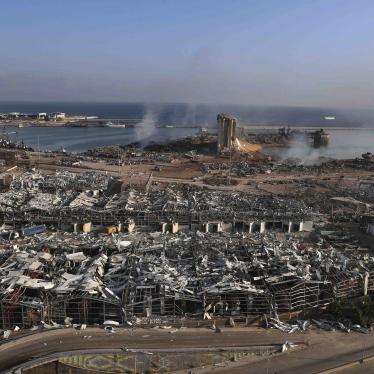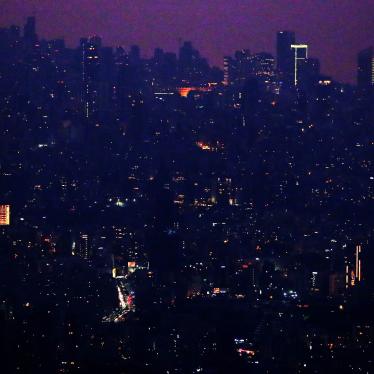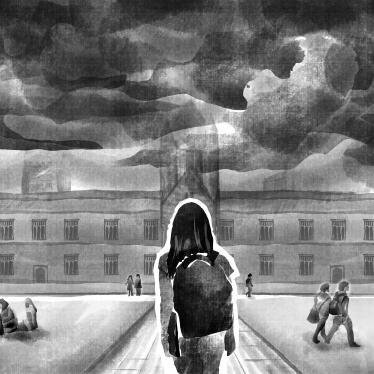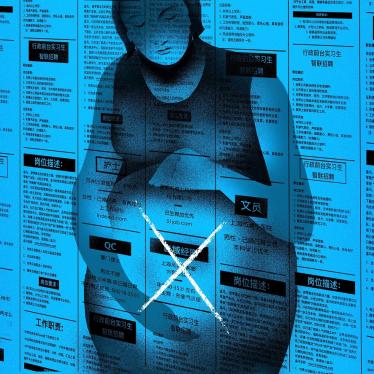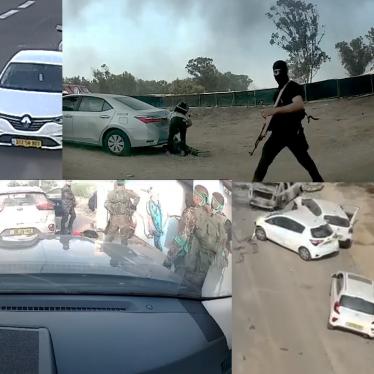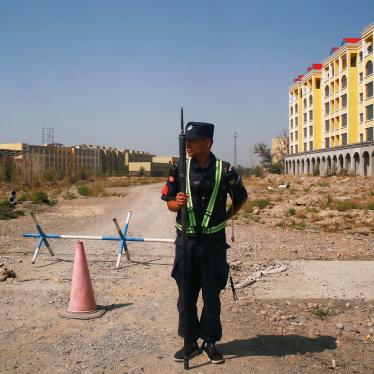閱讀這支影片的文字描述
Beirut, Lebanon
After Beirut was devastated by the August 4 explosion at the port, tens of thousands of protestors gathered in the city to express their rage and frustration over the government’s incompetence and corruption.
This video contains graphic and disturbing images. Viewer discretion advised.
Lebanese security forces used excessive and at times lethal force against mostly peaceful protestors. On August 8, Human Rights Watch witnessed beatings and assaults and were themselves mistreated by security forces ourselves.
Human Rights Watch also documented the use of live ammunition against protestors.
In this incident, security forces fired multiple live rounds at protestors as they rescued an injured man. Potentially lethal force like this should not be used unless required to protect life.
We know these were live rounds because Human Rights Watch went to the site. We found the bursts seen here in the video match the new bullet damage on the wall.
And here a soldier from the Lebanese army fires six shots from his assault rifle in the direction of the Al Amin mosque where hundreds of protestors had gathered.
For the first time, Human Rights Watch documented the use of shotgun-fired metal pellets by Lebanese security forces. These “birdshot” cartridges fired from shotguns can contain hundreds of pellets in a single round. Metal pellets were the main cause of serious injuries to protesters’ eyes and vital organs.
“Birdshot” spreads out after being fired. t many of the victims we saw were shot at close range, with dozens of pellets embedded in their bodies.
The pellets can lead to chronic pain, fatigue, nerve damage, and other serious health effects. .
Security forces also fired rubber balls at protestors, aiming at their faces, heads and necks.
Security forces launched large volumes of tear gas in downtown Beirut. One grenade, the G1 CS, is designed to be fired 200 meters and is capable of dispersing tear gas over 800 to 1,000 square meters. Around Martyr’s Square, security forces fired it directly at ambulances and health workers caring for injured protesters.
Dr, Mouin Jammal
You see someone who is providing aid, wearing a uniform, treating a bleeding wounded person, and you throw a tear gas grenade at him? Are these really soldiers?
International norms state that tear gas should be fired from a high angle and only be used to disperse unlawful or violent assemblies.
Human Rights Watch observed security forces firing tear gas cartridges directly at protesters’ heads and torsos. This woman was hit by one in the shoulder.
All Lebanese security forces have denied shooting at protestors with live ammunition. But the evidence proves otherwise.
Security forces should immediately suspend the use of shotgun-fired metal pellets and other similar ammunition. The public prosecutor should open an independent investigation into the unlawful use of force.
International donors to Lebanon’s security forces should investigate whether their support is going to abusive units, and if so, halt it immediately.
(貝魯特)- 黎巴嫩保安部隊2020年8月8日在貝魯特市中心使用過度且有時致命的武力對付大體和平的示威者。
保安部隊發射實彈、鋼珠彈和橡膠球等動能打擊投射物(kinetic impact projectiles),包括對醫護人員;警察動用過量的催淚瓦斯,包括對急救站。數枚催淚彈直接射向示威者,有些人頭部、頸部中彈。保安部隊還投擲石塊、毆打示威者。在場部隊包括國會警察、國內保安部隊(ISF)、黎巴嫩國軍(LAF)和身份不明的便服士兵。
「巴魯特市民還在為大爆炸善後,黎巴嫩安全機關沒有伸出援手,反而以驚人程度的暴力對示威者鐵腕鎮壓,」人權觀察中東副主任麥可・佩吉(Michael Page)說。「動用如此非法且過度的武力對付大體和平的示威者,顯見當局對自己的人民多麼冷酷無情。」
數萬名示威者8月8日聚集在貝魯特市中心,表達對政府和政治菁英無能與貪腐的憤怒。人民普遍認為政治菁英必須為8月4日貝魯特港區大爆炸負責,這次事故造成180人死亡、6,000餘人受傷,全市嚴重受損。
人權觀察研究人員在貝魯特現場監察8月8日至18日的抗議活動,並對25人做了訪問,包括醫生和其他醫護人員、記者和律師。人權觀察在示威現場拍攝並收集到各式彈殼,並對直接寄給研究員或從社交媒體平台收集到的保安部隊濫用武力的照片和影片做了分析。研究員指認出保安部隊使用的武器種類,並且檢視過受傷示威者的診療紀錄。
人權觀察分別在8月18、19日向陸軍和國內安全部隊提出有關保安部隊行為的問題,但直到8月25日仍未收到任何回覆。人權觀察於8月19日聯繫國會警察,簡介研究發現並徵詢意見。一名官員拒絕給出姓名,說了聲「訪問結束」就掛斷電話。
部分受訪的示威者遭軍警以霰彈槍發射的實彈、橡膠球或鋼珠彈射傷,或被催淚彈的火焰灼傷。其他人則被保安部隊士兵以拳頭、木棍或其他武器毆打。黎巴嫩紅十字會和伊斯蘭急救隊公佈,有728人在8月8日示威中負傷,其中至少153人被送醫治療。
人權觀察表示,保安部隊應立即停止使用霰彈槍發射鋼珠彈和其他無區別漫射彈藥,檢察官應對濫權問題展開獨立調查並公佈結果。黎巴嫩保安部隊的國際捐助者應調查其援助是否流向濫權單位,若是則應立即停止。
大部分示威者是和平的,但有人向保安部隊丟擲石塊、爆竹和土製汽油彈。還有些人縱火焚燒公共或私人財產。示威者曾短暫佔領對外經濟、環境和能源等部會以及銀行公會。
國內安全部隊宣佈,該部隊一名成員在救援受困樂格雷酒店(Le Grey Hotel)的民眾時殉職,另有70名成員受傷。陸軍表示有105名士兵受傷,其中2人命危。
人權觀察表示,部分示威者訴諸暴力,不能合理化保安部隊過度甚至無故使用武力。
國內安全部隊鎮暴警察和國會警察都穿著藏青色迷彩制服和防暴裝備,兩者難以區分。國會警察聲稱他們的職責限於保護國會大樓,國會周邊則由國內安全部隊和黎巴嫩陸軍負責。然而,曾有政府和軍方高級官員向人權觀察表示,國會警察應為2019年12月國會院區外圍嚴重濫用武力鎮壓示威負責。
人權觀察根據多個消息記錄,8月8日在四個不同場合發生實彈射擊示威者的事件。其中一例,有兩名士兵持衝鋒槍向示威者方向開火。另外三例中,開槍士兵的身份和單位均不明。
在這三起案例的其中一件,保安部隊向企圖抬走一名受傷男子的示威者發射實彈。人權觀察訪問到另一事件中自稱在樂格雷酒店附近大腿中彈的示威者,並且確認他的病歷記載腿部留有子彈碎片。有兩起事件的開槍者位在國會院區之內,但現場外圍的制服軍警並未加以制止。
霰彈槍發射的鋼珠彈是造成8月8日許多重傷案件的主因,示威者的眼部或其他重要器官因此受傷。人權觀察過去從未記錄到黎巴嫩保安部隊使用鋼珠彈。人權觀察表示,由於這種彈藥的不準確性質、無區別影響和過去曾致重傷的實據,不論在何種距離使用霰彈槍向示威者發射橡膠或金屬等各種粒狀物都應立即禁止。
在沒有迫切的生命威脅或重大傷害危險下使用實彈,以及用霰彈槍向大片區域無區別擊發各種投射物而可能傷及前方任何人員,這兩種情況都違反了關於執法官員使用武力的國際人權標準。
黎巴嫩陸軍8月9日聲明表示,「沒有任何士兵在貝魯特市中心向示威者發射實彈。」國內安全部隊否認向示威者發射「實彈」和橡膠子彈;國會警察也否認曾向示威者開火。
身著鎮暴裝備的警察和陸軍士兵還對示威者、醫師和記者拳打腳踢,一名人權觀察研究員被擊中嘴巴。
吉達・法蘭傑(Ghida Frangieh)——身兼法律倡議組織「法律議程」(Legal Agenda)的主席以及一群義務律師臨時組成的「律師保護示威者委員會」成員----表示,保安部隊以暴動和吸毒罪嫌逮捕了至少20名示威者。法蘭傑說,保安部隊將被捕人士押往赫盧營區(El-Helou Barracks)「非法送交」吸毒檢測,侵犯他們的隱私與健康權。
法蘭傑說,18名示威者於24小時後獲釋,2人以無關示威的罪名繼續扣留。法蘭傑並表示,律師委員會已於8月24日代表被打傷的示威者向檢察機關提交了12件刑事控告,追究下令使用實彈的官員責任,包括文職官員以及隸屬軍方、國內安全部隊或國會警察等保安部隊的指揮官。
人權律師狄耶拉・齊哈德(Diala Chehade)也已於8月19日代表一名被橡膠子彈打瞎左眼的示威者向國會警察提出刑事控告。
曾在10月抗議貪腐和經濟危機影響公眾獲得優質醫療的醫師團體「白袍」(White Shirts)8月13日透露,衛生部表示不會向醫院給付治療8月8日負傷示威者的費用。經過醫生和醫院施壓,衛生部顯然已收回成命。
司法部部長已要求檢察總長立案調查8月8日事件。但截至8月25日,檢察總長尚未公開說明他打算怎麼做。
根據國際人權法,人人享有言論與和平集會的權利,這些權利受到《公民及政治權利國際公約》保障,黎巴嫩是該公約締約國。
美、英、法等捐助國向黎巴嫩保安部隊——包括黎巴嫩陸軍和國內安全部隊——出售或捐贈了數十億美元的武器、裝備和訓練。人權觀察表示,各捐助國應該檢討相關方案,確保武器、裝備和訓練不會流向任何涉及嚴重迫害示威者的部隊。各國並應利用其影響力,要求對軍警暴行進行可靠的調查,將應負責任者移送法辦。
8月5日,黎巴嫩政府宣佈貝魯特進入為期兩週的緊急狀態,軍方因此獲得廣泛權力,所有保安部隊皆納入軍方指揮。迄今緊急狀態已兩度延長,預定9月18日結束。
「黎巴嫩當局不能用暴力打壓民怨,還以為自己可以逃脫責任,」佩吉說。「若要送出不再容忍此等濫權的強烈訊號,就必須將那些應為毆打示威者、向他們發射實彈和鋼珠彈負責的人移送法辦。」
更多內容詳見英文版。

